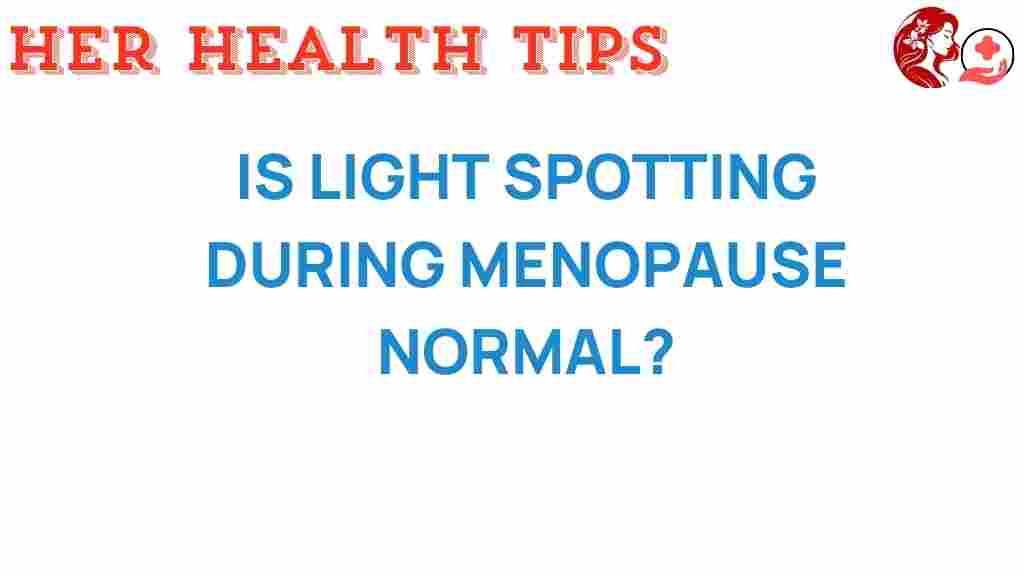Is Light Spotting During Menopause a Cause for Concern?
Menopause is a natural biological process that marks the end of a woman’s reproductive years. It is characterized by significant hormonal changes that can result in various symptoms, including irregular bleeding and light spotting. For many women, these changes can raise questions about their health and well-being. In this article, we will explore the phenomenon of light spotting during menopause, its causes, and when to seek medical advice.
Understanding Menopause and Hormonal Changes
Menopause typically occurs between the ages of 45 and 55, with the average age being around 51. This transition can be divided into three stages:
- Perimenopause: The phase leading up to menopause, where hormonal fluctuations begin.
- Menopause: Defined as having gone 12 consecutive months without a menstrual period.
- Postmenopause: The stage after menopause has occurred.
During perimenopause, women often experience irregular menstrual cycles due to fluctuating hormone levels, which can result in light spotting. This spotting can occur at various times and may be mistaken for a period.
Causes of Light Spotting in Menopause
Light spotting during menopause can be attributed to several factors, including:
- Hormonal changes: Fluctuating estrogen and progesterone levels can affect the uterine lining, leading to irregular bleeding.
- Uterine fibroids: These noncancerous growths can cause light bleeding and are common in women approaching menopause.
- Polyps: Uterine polyps can also lead to light spotting and are typically benign.
- Endometrial atrophy: Thinning of the uterine lining can result in light spotting, especially after menopause.
- Medications: Hormonal treatments or other medications can influence bleeding patterns.
Symptoms to Monitor
While light spotting can be normal during menopause, it is essential to monitor symptoms and identify any changes that may require medical attention. Consider the following:
- Duration: If light spotting lasts for more than a few days, it may be worth investigating.
- Frequency: Increased frequency of spotting can indicate an underlying issue.
- Color and Consistency: Spotting that is bright red, dark brown, or accompanied by unusual discharge should be evaluated.
- Associated Symptoms: Look for other symptoms such as pain, discomfort, or heavy bleeding.
When to Seek Medical Advice
While light spotting itself is often not a cause for concern, there are specific situations where consulting a healthcare provider is essential:
- If you experience heavy bleeding or bleeding that soaks through a pad or tampon in an hour.
- Spotting occurs after sexual intercourse.
- There are signs of infection, such as fever, chills, or unusual discharge.
- If you have a history of endometrial cancer or other reproductive health issues.
It’s crucial to prioritize women’s health and not dismiss any changes in your body, especially during this transitional phase.
Managing Light Spotting and Symptoms
There are several ways to manage light spotting and the symptoms associated with menopause:
- Maintain a healthy lifestyle: Regular exercise and a balanced diet can help manage weight and hormonal balance.
- Stay hydrated: Adequate hydration is vital, especially during hormonal changes.
- Consider hormonal therapies: Hormonal treatments may be beneficial for some women; discuss options with your healthcare provider.
- Monitor your symptoms: Keeping a diary of your symptoms can help identify triggers and patterns.
Step-by-Step Process to Address Light Spotting
If you are experiencing light spotting and are unsure about its significance, follow this step-by-step process:
- Track Your Symptoms: Keep a record of when the spotting occurs, its duration, and any other symptoms.
- Evaluate Changes: Note any recent changes in medications, lifestyle, or stress levels that could contribute to hormonal fluctuations.
- Consult with a Healthcare Provider: Schedule an appointment if spotting persists or is accompanied by concerning symptoms.
- Discuss Diagnostic Tests: Your doctor may recommend tests such as ultrasounds, blood tests, or biopsies to determine the cause of spotting.
- Follow Recommended Treatments: Adhere to the treatment plan prescribed by your healthcare provider to manage symptoms effectively.
Troubleshooting Tips for Irregular Bleeding
If you are experiencing irregular bleeding or light spotting, consider these troubleshooting tips:
- Review Medications: Discuss any medications with your doctor, as some can affect hormonal balance.
- Manage Stress: Stress can exacerbate hormonal changes; consider relaxation techniques like yoga or meditation.
- Diet and Nutrition: Incorporate foods rich in omega-3 fatty acids, vitamins, and minerals to support hormonal health.
- Regular Check-ups: Maintain regular gynecological exams to monitor reproductive health.
For more information on menopause and women’s health, you can visit WomensHealth.gov.
Conclusion
In summary, light spotting during menopause can be a common occurrence due to hormonal changes and other factors. While it is often not a cause for concern, it is essential for women to be proactive about their reproductive health and monitor any changes. Keeping track of symptoms, seeking medical advice when necessary, and managing your health holistically can help you navigate this transitional phase with confidence. Remember, prioritizing your health and well-being is crucial during this time of change.
Take charge of your health and consult your healthcare provider with any questions or concerns regarding light spotting or other menopausal symptoms. Your health journey is important, and being informed is the first step toward maintaining your well-being.
This article is in the category Reproductive and created by HerHealthTips Team
